Heavy-duty diesel engines can run for millions of kilometres with the right maintenance schedule. Simple construction and tough internal components mean that diesels are unlikely to fail all of a sudden.
But diesels still need servicing, and the colour of the exhaust can tell you a lot about the condition of the engine. Black, white, blue or grey diesel exhaust can all indicate that something is wrong with the vehicle.
Diagnosing unusual exhaust colours can be a challenge. It’s normal for your exhaust to have a slight colouration at times, and each colour can represent a handful of different issues. In this article we’ll discuss diagnosing black, white, blue or grey smoke from your diesel exhaust.
White Smoke From Diesel Exhaust
Diesel engines may blow white exhaust.
If you live in a cold climate and your exhaust produces a thin, white smoke when you first start the vehicle, this is caused by a form of condensation. This usually isn’t a problem if the smoke goes away within a few minutes.
Thicker clouds of white smoke that don’t fade away after running the engine indicate much bigger issues.
Causes of white diesel smoke
White smoke from your diesel exhaust usually indicates unburnt fuel or coolant entering the combustion chamber. This often points to issues with fuel delivery, engine temperature, or internal sealing. The most common causes include:
It’s common for diesels that are blowing thick, white smoke to also run poorly. If the engine seems lumpy, sluggish or low on power, switch it off and contact your diesel mechanic. Running an engine that is blowing white smoke can cause serious damage.
Don’t Ignore an Abnormal Exhaust, Get Your Vehicle Inspected
If you’re concerned about the colour of your diesel exhaust, book an inspection with KS Mobile Diesel. KS Mobile Diesel is a mobile diesel mechanic based in Caboolture, and servicing all over the Brisbane region.
Our mobile fleet is equipped to service light and heavy trucks, Buses, trailers, earthmoving and agriculture equipment, 4WDs and much more.
Contact us today to book an appointment. We’ll come to you and provide full diagnostics, maintenance and repairs!
Blue or Grey Smoke From Diesel Exhaust When Accelerating
Blue or grey smoke when accelerating is one of the most common complaints on diesels. These two colours of exhaust smoke are actually caused by the same thing: the engine burning excessive amounts of oil.
In all engines, oil is used to lubricate internal components. Small amounts of oil are burned during normal operation. If the engine starts burning too much oil, the exhaust may look blue or grey, depending on the severity of the issue.
It’s fairly common for diesel engines to blow blue smoke in cold climates. If the smoke goes away once the engine has warmed up, there’s no need to panic. If the blue smoke persists then you need to contact a mechanic.
Common Causes of Grey Smoke
Grey smoke from your diesel exhaust typically indicates oil burning in the combustion chamber. The most common causes include:
Your mechanic can perform a simple compression test to determine where the problem is located. Engines that burn large amounts of oil may need to be rebuilt, or the head may need to be rebuilt. This is a large task, but rebuilt components can deliver years of trouble-free operation.
Black Smoke From Diesel Exhaust
Small amounts of black smoke are normal for diesel engines. Black smoke contains carbon particles, hence its colour. Excessive amounts of black smoke usually indicate that something is wrong with the fuel combustion system.
Common cause of black smoke from exhaust
Black smoke from your diesel exhaust usually means the engine is burning too much fuel or not receiving enough air. This imbalance leads to incomplete combustion, which produces the thick, dark smoke seen under load or acceleration. The most common causes include:
If you notice black smoke coming from your diesel exhaust, put the vehicle in neutral and increase the engine speed. Watch the amount of black exhaust as the RPMs increase. While small amounts of black smoke are normal, the exhaust should be mostly colourless as the engine heats up and as you accelerate.

Impact on Your Engine and The Environment
Different types of diesel exhaust smoke can be bad for you vehicle, your health, and the environment.
White smoke can signal serious issues such as injector faults or coolant leaks, which reduces engine efficiency and releases harmful hydrocarbons into the atmosphere.
Grey smoke typically indicates that the engine is burning oil. Burning oil increases particulate emissions, contributes to air pollution and can rapidly escalate engine wear if not addressed. It’s also a sign that lubricating oil is being consumed faster than normal, which leads to higher operating costs and potential engine damage.
Black smoke is the most noticeable and contains high levels of soot and particulate matter, making it environmentally harmful. Black smoke can be caused by clogged air filters, faulty injectors or turbocharger underperformance, all of which reduce fuel economy and engine longevity.
Preventive Maintenance for Diesel Exhaust Smoke
Staying ahead of potential issues is the best way to minimise white, grey and black smoke from your diesel engine. Key preventative steps include:

When to Call a Professional Mechanic
While basic maintenance can prevent many smoke-related issues, some symptoms require expert diagnosis. It’s important to contact a professional mechanic if smoke persists after routine checks, appears suddenly under normal driving conditions or worsens with load or acceleration.
Don’t Ignore an Abnormal Exhaust, Get Your Vehicle Inspected by KS Mobile Diesel
The colour of your diesel exhaust can tell you a lot about how well the engine is functioning. While it’s normal to see small amounts of white, grey or black exhaust under normal use, excessive smokiness can be a sign that something is seriously wrong.
If you’re concerned about the colour of your diesel exhaust, book an inspection with KS Mobile Diesel. KS Mobile Diesel is a mobile diesel mechanic based in Caboolture. We work all over the Brisbane region, providing inspections, maintenance and repairs for diesel vehicles and equipment. Our mobile fleet is equipped to service light and heavy trucks, Buses, trailers, earthmoving and agriculture equipment, 4WDs and much more.
Contact us today to book an appointment. We’ll come to you and provide full diagnostics, maintenance and repairs!
Diesel Exhaust Smoke FAQs
Grey smoke indicates oil burning in the combustion chamber, which can lead to engine damage if left untreated. While not immediately dangerous to your health, it signals problems that will worsen over time and may eventually lead to engine failure.
While you can drive short distances in an emergency, continuing to drive with grey smoke can cause accelerated engine wear, reduced fuel efficiency, and potentially catastrophic engine damage. We recommend diagnosing and addressing the issue as soon as possible.
Blue and grey smoke both indicate oil burning, but with subtle differences. Pure blue smoke typically suggests more severe oil burning, while grey smoke may indicate a smaller amount of oil in the combustion process. In diesel engines, the terms are often used interchangeably.
Bad fuel typically causes black smoke (indicating incomplete combustion). Grey smoke is almost always related to oil entering the combustion chamber rather than fuel quality issues.
